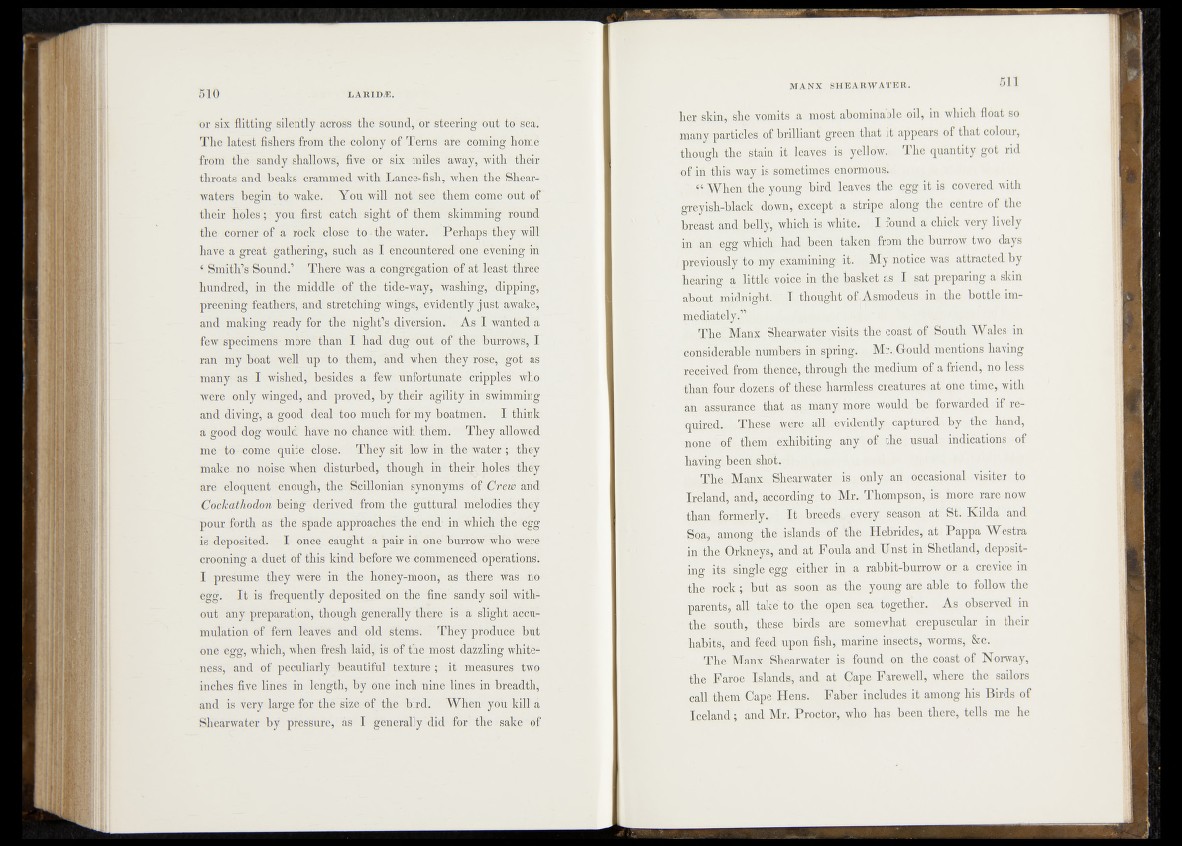
or six flitting silently across the sound, or steering out to sea.
The latest fishers from the colony of Terns are coming home
from the sandy shallows, five or six miles away, with their
throats and beaks crammed with Lance-fish, when the Shearwaters
begin to wake. You will, not see them come out o f
their holes; you first catch sight of them skimming round
the corner of a rock close to • the,water. Perhaps they;will
have a great gathering, such as I encountered one evening in
4 Smith’s Sound.’ There was a congregation of at least three
hundred, in the middle of the tide-way, washing, dipping.,
preening feathers, and stretching wings,^evidently just awake,;
and making ready for the night’s diversion* As 1 wanted a
few specimens- more than I had dug out of the burrows, I
ran my boat well up to them, and when they rose, got as
many as I wished, besides a few unfortunate cripples who
Were only winged, and proved,, by their agility? in swimming
and diving, a good deal too much for my boatmen. I think
a good dog would have no chance with them; They allowed
me to come quite close. They sit low in the water; they
make, no noise when disturbed, though in their. holes they
are eloquent enough, the Scillonian synonyms of Crew and
Coclcathodon being derived from the guttural melodies they
pour forth as the spade approaches the end- in whieh the egg
is deposited. I once caught. a pair in one burrow who were
crooning a duet of this kind before we commenced operations.
I presume they were in the honey-moon, as there was no
egg. I t is frequently deposited on the fine' sandy soil without
any preparation, though generally there is a slight accumulation
of fern leaves and old stems. They produce but
one egg, which, when fresh laid, is: of the most dazzling whiteness,
and of peculiarly beautiful texture; it measures two
inches five lines in length, by one inch nine lines in breadth,
and is very large for the size of the bird. When you kill a
Shearwater by pressure, as I generally did for the sake of
her skin, she vomits a most abominable oil, in which float so
many particles, of brilliant green that it appears of that colour,
though the stain it leaves is yellow. The quantity got rid
of in this way is sometimes enormous.
“ When the young bird leaves the egg it is covered with
greyish-black down, éxcept a stripe along the centre of the
breast and belly, which is whiter I found a chick very lively
in an egg which had been taken , from the burrow, two days
previously to my examining it. My notice was attracted by
hearing, a little voice in the basket as I sat preparing a skin
about midnight. I thought of. Asmodeus in • the bottle immediate^”
The- Manx Shearwater visits the coast of South Wales in
considerable numbers in spring. Mr..Gould mentions having
received from thence,- through the medium of a friend, no less
than four dozens.of these harmless creatürës at one time, with
an assurance that as many more would be forwarded if required.
These; weré all .ëvidently: captured by the hand,
none ~of them: exhibiting any of the, usual indications of
having been •shot.-l;
Thé Manx Shearwater is only an occasional visiter to
Ireland, and, according to Mr. Thompson, is more rare now
than formerly. It breeds évery season at St. Kilda and
Squ, among the islands of the Hebrides, at Pappa W^estra
in the Orkneys, and at Foula and Unst in Shetland, deposit-
ins' its sinsrle esrs either in a rabbit-p o oo burrow or a crevice in
the rock; but as soon as the young are able to follow the
parents, all take to the open sea together. As observed in
the south, these birds are somewhat crepuscular in their
habits, and feed upon fish, marine insects, worms, Sec.
The Manx Shearwater is found on the coast of Norway,
the Faroe Islands, and at Cape Farewell, where the sailors
call them Cape Hens. Faber includes it among his Birds of
Iceland; and Mr. Proctor, who has been there, tells me he